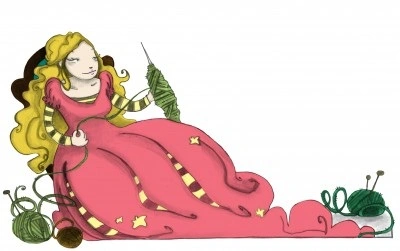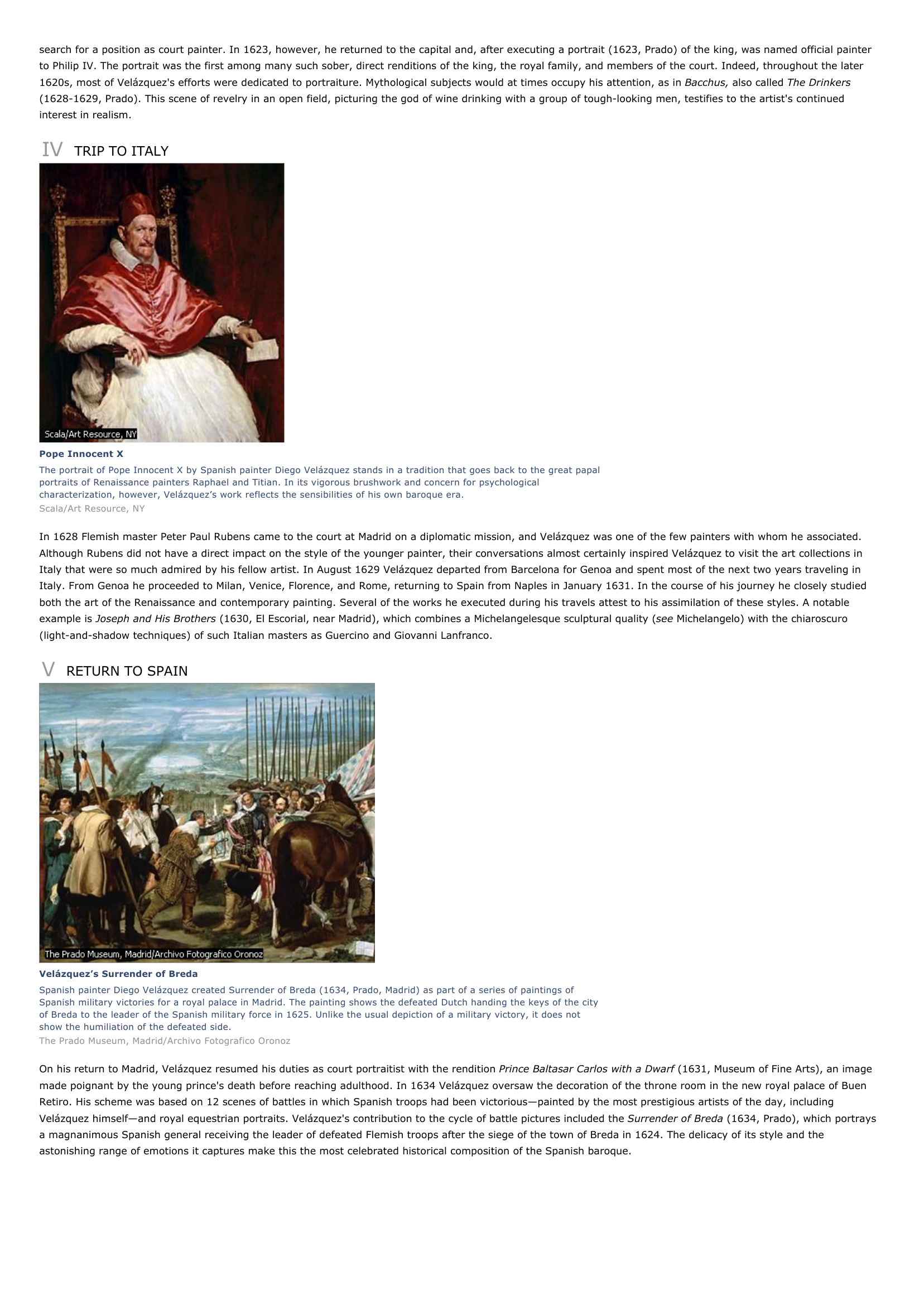Diego Velázquez (artist) I INTRODUCTION Velázquez and Baroque Theatricality Spanish painter Diego Velázquez presents two scenes in The Fable of Arachne (about 1656, Museo del Prado, Madrid, Spain), also known as The Spinners.
Publié le 12/05/2013

Extrait du document


«
search for a position as court painter.
In 1623, however, he returned to the capital and, after executing a portrait (1623, Prado) of the king, was named official painterto Philip IV.
The portrait was the first among many such sober, direct renditions of the king, the royal family, and members of the court.
Indeed, throughout the later1620s, most of Velázquez's efforts were dedicated to portraiture.
Mythological subjects would at times occupy his attention, as in Bacchus, also called The Drinkers (1628-1629, Prado).
This scene of revelry in an open field, picturing the god of wine drinking with a group of tough-looking men, testifies to the artist's continuedinterest in realism.
IV TRIP TO ITALY
Pope Innocent XThe portrait of Pope Innocent X by Spanish painter Diego Velázquez stands in a tradition that goes back to the great papalportraits of Renaissance painters Raphael and Titian.
In its vigorous brushwork and concern for psychologicalcharacterization, however, Velázquez’s work reflects the sensibilities of his own baroque era.Scala/Art Resource, NY
In 1628 Flemish master Peter Paul Rubens came to the court at Madrid on a diplomatic mission, and Velázquez was one of the few painters with whom he associated.Although Rubens did not have a direct impact on the style of the younger painter, their conversations almost certainly inspired Velázquez to visit the art collections inItaly that were so much admired by his fellow artist.
In August 1629 Velázquez departed from Barcelona for Genoa and spent most of the next two years traveling inItaly.
From Genoa he proceeded to Milan, Venice, Florence, and Rome, returning to Spain from Naples in January 1631.
In the course of his journey he closely studiedboth the art of the Renaissance and contemporary painting.
Several of the works he executed during his travels attest to his assimilation of these styles.
A notableexample is Joseph and His Brothers (1630, El Escorial, near Madrid), which combines a Michelangelesque sculptural quality ( see Michelangelo) with the chiaroscuro (light-and-shadow techniques) of such Italian masters as Guercino and Giovanni Lanfranco.
V RETURN TO SPAIN
Velázquez’s Surrender of BredaSpanish painter Diego Velázquez created Surrender of Breda (1634, Prado, Madrid) as part of a series of paintings ofSpanish military victories for a royal palace in Madrid.
The painting shows the defeated Dutch handing the keys of the cityof Breda to the leader of the Spanish military force in 1625.
Unlike the usual depiction of a military victory, it does notshow the humiliation of the defeated side.The Prado Museum, Madrid/Archivo Fotografico Oronoz
On his return to Madrid, Velázquez resumed his duties as court portraitist with the rendition Prince Baltasar Carlos with a Dwarf (1631, Museum of Fine Arts), an image made poignant by the young prince's death before reaching adulthood.
In 1634 Velázquez oversaw the decoration of the throne room in the new royal palace of BuenRetiro.
His scheme was based on 12 scenes of battles in which Spanish troops had been victorious—painted by the most prestigious artists of the day, includingVelázquez himself—and royal equestrian portraits.
Velázquez's contribution to the cycle of battle pictures included the Surrender of Breda (1634, Prado), which portrays a magnanimous Spanish general receiving the leader of defeated Flemish troops after the siege of the town of Breda in 1624.
The delicacy of its style and theastonishing range of emotions it captures make this the most celebrated historical composition of the Spanish baroque..
»
↓↓↓ APERÇU DU DOCUMENT ↓↓↓
Liens utiles
- Francisco José de Goya y LucientesIINTRODUCTIONFrancisco de GoyaOne of the great masters of Spanish art, painter and illustrator Francisco José de Goya y Lucientes produced works ofconsiderable beauty and power.
- Popular Music I INTRODUCTION Satchmo Sings "Back O' Town Blues" One of the founders of instrumental jazz music, American Louis Armstrong, known as Satchmo, also profoundly influenced vocal jazz and popular song.
- William Blake I INTRODUCTION William Blake (1757-1827), English poet, painter, and engraver, who created an unusual form of illustrated verse; his poetry, inspired by mystical vision, is among the most original, lyric, and prophetic in the language.
- Luciano PavarottiIINTRODUCTIONLuciano PavarottiRenowned Italian tenor Luciano Pavarotti was known for his mastery of the highest notes of a tenor's range and for hisjovial personality, which helped him earn a wide popular following.
- Homer I INTRODUCTION Homer According to tradition, the Greek poet Homer is believed to be the author of the Iliad and the Odyssey, two great epics of ancient Greek literature.
















